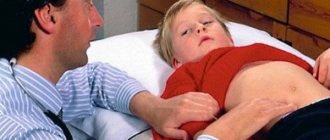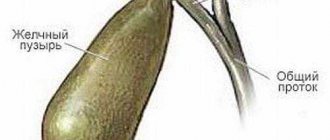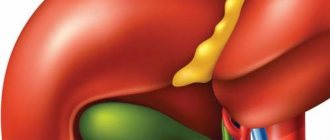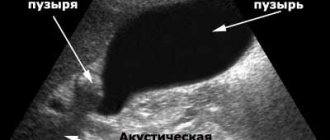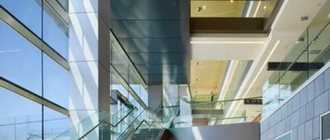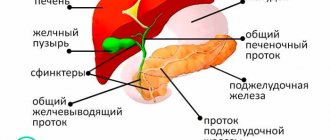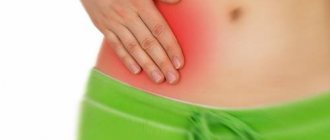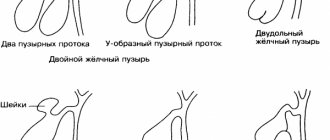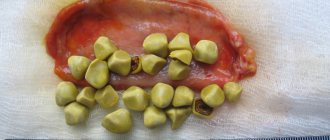Sand in the gallbladder is the initial stage of gallstone disease. The formation of microconcretions is a fairly common pathology. Sand consists of bile components, among which cholesterol occupies the main place. The pathology is practically asymptomatic, but it is more dangerous than it might seem at first glance. Unremoved sand eventually forms stones and provokes cholecystitis. A physician, gastroenterologist or hepatologist identifies symptoms and treats sand in the gallbladder.
How sand is formed
Bile secreted by the liver contains many components. They are needed to digest food in the duodenum. The liver produces up to 2 liters of bile per day. But not all of it is used at the same time. The function of storing this important biological fluid is performed by the gallbladder, releasing the required amount of bile as food arrives.
Under the influence of provoking factors, the proportional ratio of the composition of bile is disrupted and biliary sludge is formed - sediment. It consists of cholesterol crystals, pigments, calcium salts and other elements found in the structure of bile.
If the cause of the formation of bile sludge is not eliminated, over time the sediment turns into sand or microconcretions with a diameter of about 1 mm. The process of stone formation does not stop there. The stones increase in size to 1 cm or more.
Approximately 90% of the sand in the bladder is cholesterol.
Prevention
It is not always possible to prevent the development of the disease. If one of the parents has chronic gallstone disease, the child is likely to develop it. However, often the problem is caused by human error, and in such cases it could have been prevented.
Preventive measures are the following rules:
- stop smoking, limit alcohol consumption or give it up altogether;
- add fresh vegetables, fruits, and juices based on them to your daily diet;
- Monitor your weight; if you are obese, follow a diet;
- give up fast food and other junk food;
- do not use hormonal and other potent drugs other than as prescribed by a doctor;
- provide moderate physical activity;
- avoid stress and nervous tension;
- Get a routine check-up every year at your local clinic;
- If you have any complaints from the gastrointestinal tract, immediately contact a gastroenterologist.
Compliance with these rules will help prevent the development of many diseases of the digestive system.
Sand in a bladder is dangerous because it has mild symptoms; some go to the hospital only when gallstone disease has already begun to develop. It is important to respond in time to any abnormalities in the digestive system in order to undergo diagnostics and identify the problem. Treatment should be comprehensive, it includes drug therapy, diet, the use of herbal remedies and other folk remedies.
Causes and provoking factors
Predisposing factors to the formation of sand grains are primarily considered to be gender and age. According to statistics, the number of women with sand in the gallbladder is many times greater than the number of men with this disease. Age also makes itself felt. Over the years, the tone of internal organs decreases, and the risk of sand appearing after 70 years is already 30%.
The next at risk are people with an obese physique who lead an inactive lifestyle. Among the total number of patients, the proportion of obese people is 65%.
A genetic factor can play a decisive role when a person is born with an abnormal structure of an organ (kink, constriction). These deficiencies interfere with the normal flow of bile.
Hormonal disorders and other diseases also lead to the formation of sand:
- diabetes;
- liver diseases;
- pathologies of the gastrointestinal tract;
- gout;
- taking hormonal medications;
- pregnancy.
An important factor in the progression of the disease is nutrition. The predominance of fatty foods, sweets, carbonated drinks, and alcohol in the diet significantly provokes sand deposition. The same thing happens during long periods of fasting and following strict diets.
Advantages and disadvantages
| pros | Minuses |
|
|
Sand symptoms
It is quite difficult to determine the presence of grains of sand, since in the first stages a person is not bothered by specific symptoms. Sand can form over several years. Most often it is discovered accidentally during the diagnosis of other diseases.
However, some signs of general malaise suggest the need to check the condition of the gallbladder:
- constant fatigue;
- difficulty falling asleep;
- rapid physical and mental fatigue;
- indigestion;
- nausea after eating fatty foods or alcohol.
When the stones reach large sizes and begin to move, a severe attack of pain occurs - hepatic colic. The heart rate increases, blood pressure decreases, and even loss of consciousness is possible.
Why is it dangerous?
Sand in the gallstone is not the last stage of the pathological process of stone formation. Stones up to 2-3 mm in size can pass through the bile duct into the intestines without causing harm to other organs.
But over time, the stones grow in size, reaching several centimeters. When it enters the bile ducts, choledocholithiasis develops. When a situation occurs that provokes the movement of large particles, they can injure the walls of the duct or completely block it. An infection enters the gall bladder and inflammation begins - cholecystitis.
Severe attacks of hepatic colic with large stones require immediate surgical intervention.
Folk remedies and herbs for the treatment of cholelithiasis
Based on localization, the following types of cholelithiasis are distinguished:
- choledocholithiasis - the formation of stones occurs in the bile ducts;
- cholecystolithiasis – stones form in the gallbladder.
Depending on the composition, the following types of stones are distinguished for cholelithiasis:
- cholesterol stones - consist of cholesterol, bilirubin, salts, protein, minerals, have a yellowish color, this type of stones is observed in approximately 80% of cases;
- limestones - consist of lime salts;
- pigment stones - consist of bilirubin, cholesterol deposits, calcium salts, are black or dark brown in color;
- mixed stones - consist of all of the above substances and are quite common.
There are 4 stages of gallstone disease:
First stage (initial) . The composition of the bile changes, but there are no stones yet. At this stage, the disease is asymptomatic, and pathological changes can only be detected using a biochemical analysis of bile.
Second stage . Stones begin to form, but there are no symptoms other than a rare feeling of abdominal discomfort. Cholelithiasis can be detected at this stage using radiography or ultrasound.
Third stage . The stones are fully formed, a clinical picture of cholelithiasis is observed, and cholecystitis may develop.
Fourth stage . Complications of the disease develop.
Causes of gallstone disease
The main reasons for the formation of stones are:
- bile stagnation - occurs due to a disruption of the normal outflow of bile caused by mechanical obstacles (tumors, scars, hypertrophy of the mucous membrane of the bile ducts and a number of others);
- disturbance of the metabolism of phospholipids, cholesterol, bile acids , and what is important is not the increase or decrease in their quantity, but the imbalance between these substances;
- inflammation of the gallbladder - with this pathology, the cells of the mucous membrane rapidly die and tear away from it, and it is on them that the components of the future stone settle.
In addition, there are a number of factors that can trigger the development of gallstone disease. These include:
- liver pathologies;
- poor nutrition;
- sedentary lifestyle;
- some infectious diseases;
- eating large amounts of meat products;
- weakening of the motor function of the gallbladder;
- alcohol abuse;
- hormonal disbalance.
Symptoms of gallstone disease
In the early stages, the disease is asymptomatic. Several decades may pass from the onset of the pathological process to the first clinical manifestations in the form of abdominal pain.
The main clinical signs of cholelithiasis are pain in the right side and lower back, a regularly occurring bitter taste in the mouth, and a yellowish tint to the whites of the eyes and skin.
An attack of cholelithiasis should be distinguished from stomach pain and angina attacks. With cholelithiasis, abdominal pain always appears some time after eating.
When you press on the stomach, on the right, under the ribs, the pain intensifies significantly, especially if you press on the stomach while inhaling. In addition, with gallstone disease, digestive disorders such as bloating and indigestion are periodically observed.
Diagnosis of cholelithiasis
If any suspicious symptoms appear, you should immediately consult a doctor and undergo an examination. The main stages of diagnosing gallstone disease are:
- collecting anamnesis, interviewing the patient;
- palpation and percussion of the abdominal cavity (reveals pain in the right hypochondrium);
- blood test (general) - reveals an increased ESR and an increase in leukocytes;
- urinalysis (general) – increased bilirubin content;
- blood test (biochemical) - increased levels of cholesterol, bilirubin, AST, ALT, alkaline phosphatase;
- CT, MRI;
- Ultrasound of the abdominal organs;
- cholecystography;
- scintigraphy of the biliary tract.
Treatment of cholelithiasis
The main goals of treatment for the disease are: getting rid of stones in the bile ducts and eliminating the cause of their formation to prevent relapses of the disease.
For this, the patient is prescribed the following treatment methods:
- Diet No. 5 . Nutrition should be balanced and rational. The consumption of foods high in fiber (bran, vegetables, herbs, fruits), cereals, chicken, and lean beef is recommended. You should completely avoid alcohol, spicy, fatty, fried, canned, smoked and too hot foods.
- Bile acid preparations . Prescribed in the early stages of cholelithiasis, when the stones are not yet too large.
- Hepatoprotectors . These drugs help restore hepatocytes (liver cells).
- Antibiotics . Prescribed for the development of acute inflammation of the bile ducts (cholangitis) and inflammation of the gallbladder (cholecystitis). If a patient experiences an attack of hepatic colic (severe pain in the right side associated with stagnation of bile), then you should immediately call an ambulance. You should not take any independent measures before the doctor arrives, including giving painkillers, as this can blur the clinical picture and complicate the diagnosis of the disease.
- Surgery. It involves removing the gallbladder along with the stones. The operation is carried out in two ways:
- classic - the abdominal wall is opened and the gallbladder is removed along with the stones;
- Laparoscopy is a minimally invasive operation; all manipulations are performed through small punctures in the abdominal wall under ultrasound guidance.
In recent years, laparoscopic operations have become increasingly popular because they are low-traumatic, which ensures rapid wound healing and shortens the rehabilitation period. In addition, after laparoscopic operations there are no cosmetic defects in the form of scars.
Folk remedies for gallstone disease
Traditional medicine methods have been tested by generations of our ancestors . Proper treatment with freshly squeezed juices, infusions and decoctions gives excellent results without any side effects for the body.
In moderate cases, cholelithiasis can also be cured using traditional medicine. Treatment is based on agents that dissolve stones and promote the removal of stagnant bile. It must be remembered that with stones with a diameter of 1-2 mm, choleretic agents cause biliary colic.
Before you begin treatment, consult your physician.
Fasting and diet
In case of exacerbation of cholelithiasis, fasting for several days and subsequent strict diet is recommended. Throughout the day you need to drink hot water - up to ten glasses. Juice squeezed from one lemon is added to each of them.
Fresh juice from fresh beets, carrots and cucumbers is very useful during this period. Three glasses of juice per day are enough. On the second day, pain and cramps may appear, indicating the removal of sand and stones from the body. After a week of such treatment, a break is taken, and after a certain time the course is repeated.
This method will cure cholelithiasis forever.
Juice therapy is an affordable and effective method of treatment practiced by traditional medicine.
We offer proven recipes for preparing and consuming medicinal juices:
- Before eating, drink one tbsp. a spoonful of black radish juice with honey.
- For pain in the liver, do fasting days on juice squeezed from carrots, celery and parsley.
- Mix 12 cups fresh tomato juice with 12 cups cabbage juice or brine. A good effect is ensured by long-term use of this mixture, beneficial for the body.
- Regularly drinking beetroot juice is another proven method in which stones dissolve without pain.
Decoctions for the treatment of disease
- Take a few beetroot tubers and cook until the water reaches the consistency of a thick syrup. You need to drink 3-4 glasses a day. Beetroot broth helps dissolve stones.
- Place birch leaves in a steam bath and keep them for 20 minutes. Drink a cup of filtered broth three times a day.
- For symptoms of cholelithiasis, it is useful to drink a decoction of dandelion root. To do this, grind the raw materials and put one teaspoon in a glass of boiling water, boil for 20 minutes. Drink the decoction during the day, a quarter of a glass.
- A collection of chamomile, wild rosemary, lily of the valley, string, motherwort, mint, hawthorn, rose hips, valerian root, buckthorn and calamus. Take 5 grams of each ingredient, add 1.5 liters of water, boil for 5 minutes, leave for 6 hours. Drink 3 times, consuming 100 ml half an hour before breakfast, lunch and dinner.
Infusions for removing stagnant bile and dissolving stones
- Immortelle leaves (2 tablespoons) are infused in 200 ml of boiling water. Drink filtered, half a glass twice a day.
- An infusion of 2 teaspoons of geranium in 400 ml of cold water will help dissolve the stones. Infuse for 7 hours in the dark, drink 2 sips during the daytime.
- Take the same amount of St. John's wort, knotweed, celandine, tricolor violet, corn silk, dandelion roots, coriander and anise seeds, combine and mix. Three tablespoons of the mixture are poured into three glasses of boiling water and left for half an hour. Drink a glass strained three times a day.
- Take equal parts of the herb celandine, leaves of the trifoliate, chamomile inflorescences, mix. Add 1 tbsp to 250 ml of boiling water. spoon of the composition, cover tightly with a lid and leave. After an hour, drink filtered, half a glass an hour after meals in the morning and evening.
- Combine angelica officinalis root, caraway fruits, peppermint leaves, sage, buckthorn bark in equal proportions. Steam one tbsp in 250 ml of boiling water. collection spoon. Infuse for one hour, drink 30 minutes before breakfast, lunch and dinner.
- Combine equal parts of knotweed, bear's ears, smooth hernia, corn silk and bean pods. One tbsp. Steam a spoonful of the mixture in 250 ml of boiling water, leave and drink throughout the day.
- Take two parts of rhubarb, three parts of immortelle inflorescences, five parts of yarrow. Mix and place 1 tbsp in a thermos. spoon, add 250 ml of boiling water. Let stand for one hour, drink two-thirds of a glass before bed.
Prevention of gallstone disease
The main measures to prevent the disease are:
- giving up alcohol;
- giving up a sedentary lifestyle - physical exercise, regular walks in the fresh air;
- proper nutrition;
- timely treatment of gastrointestinal diseases;
- regular sanitation of foci of chronic infection in the body;
- hardening the body, increasing immune defense;
- normalization of work and rest regimes;
- weight control, preventing the development of obesity;
- refusal of uncontrolled use of medications; they should be prescribed only by the attending physician; self-medication is unacceptable and can lead to the development of a number of serious complications;
- avoiding stress;
- compliance with basic rules of personal hygiene;
- Regular preventive examinations will help identify possible diseases at an early stage, which will significantly facilitate subsequent treatment and help avoid complications.
Where can I buy
A huge selection of folk remedies or ingredients for their preparation is offered by the Russian Roots online store. Remedies for gallstone disease can also be purchased at any of the herbal pharmacies in Moscow owned by the company.
The online store is a convenient platform for purchasing traditional medicine, which you can order by phone or on the website. Delivery of goods in Moscow and the nearest Moscow region is carried out by couriers. When sending to other regions, the company uses postal services.
The online store offers only high-quality traditional medicine that meets environmental standards. Call and order products for the treatment of gallstone disease in the Russian Roots online store.
Attention! All materials published on our website are protected by copyright. When re-publishing, attribution and a link to the original source are required.
Source: https://magazintrav.ru/zhelchekamennaja_bolezn_narodnye_sredstva_i_travy
What tests need to be taken
A gastroenterologist deals with issues of gallbladder diseases. To begin with, he himself examines the mucous membranes and palpates the stomach. Next, he prescribes additional examinations.
Diagnosis is carried out using ultrasound. The presence of crystallized impurities becomes obvious during the study. Computed tomography and MRI provide an even clearer picture of the condition of the gallbladder and the sediment it contains.
In addition, it may be necessary to determine the level of cholesterol in the blood, since it is the main component of bile sand. To assess liver function, you need to take a biochemical blood test.
Features of treatment
Treatment of sand in the gallbladder is predominantly conservative. Many people make the mistake of ignoring the presence of sludge. But with heterogeneity of bile and fine suspension of particles, there remains a high risk of stone formation. Experts know how to treat sand in the gallbladder and how to remove it from the body.
Preparations Ursosan, Ursofalk
For this purpose, ursodeoxycholic acid preparations (Ursosan, Ursofalk) are most often used. They are prescribed in a standard dosage - 10 mg per kg of body weight once before bedtime for 1-3 months. After the course of therapy, it is necessary to re-perform ultrasound diagnostics.
Choleretic herbs and herbs
But ursodeoxycholic acid is not the only remedy that needs to be taken for biliary sludge. Sand in the gallbladder can be removed using special choleretic preparations or preparations based on certain herbs. An example of such a remedy is Gepabene. It is often recommended to those people who do not know how to expel sand from the gallbladder and cannot get rid of it for many years.
Gepabene and similar drugs, including conventional choleretic preparations, do not allow bile to stagnate, ensure its constant circulation and reduce lithogenicity. To enhance the effect of conservative treatment, it is recommended to additionally use ursodeoxycholic acid and regularly perform gallbladder tubing with sorbitol or magnesium sulfate. If, against the background of bile removal, bitterness appears in the mouth, it is recommended to use prokinetics (Motilium).
Duodenal intubation and surgery
If conservative therapy is ineffective, it is recommended to carry out minimally invasive treatment using duodenal intubation. Forced release of the gallbladder from lithogenic bile has a positive effect on the functioning of the entire biliary tract. If sand provokes the development of pancreatitis and other dangerous complications, it is necessary to perform cholecystectomy - surgical removal of the gallbladder.
How to get rid of sand
It is important not only to detect sand in the bladder, but also to know how to treat the disease. Based on the examination results and the patient’s condition, the doctor assesses the severity of the disease and prescribes appropriate treatment. The complex of measures to combat sand in the gallbladder includes treatment with medications, physical procedures and, of course, a diet.
Drugs
To get rid of sand in the gallbladder, a specialist will prescribe appropriate medications. The most commonly prescribed drugs for sand are:
- choleretic (Ursohol, Odeston), but in no case should they be taken if stones are present;
- dissolving sand and stones (Ursosan, Ursofalk);
- hepatoprotectors (Hofitol, Rafacholine C);
- painkillers (Analgin, Baralgin);
- antispasmodics (No-shpa, Drotaverine, Spazgan).
The last two categories of drugs can be administered intramuscularly during an attack to accelerate the therapeutic effect.
During treatment, the use of oral contraceptives is prohibited.
Procedures
In some cases, the doctor selects options for removing sand from the gallbladder mechanically. For this, a laser or shock wave method is used, each of which involves crushing large stones.
In severe cases, these methods are not used due to possible negative consequences. Then the gallbladder has to be removed.
Diet
To remove sand from the gallbladder, you first need to limit the consumption of foods containing cholesterol. After all, it is the main component of sand. To do this, you will need to give up fatty meats and fish, animal fats, spicy seasonings, alcohol, and fast food products.
You need to adhere to dietary recommendations for at least six months (table No. 5):
- eat little but often;
- chew food thoroughly;
- increase the consumption of pure still water to 1.5-2 liters per day;
- When cooking, use only vegetable oils;
- increase the amount of plant fiber in the diet.
Of the heat treatment methods, only boiling, baking and steaming are allowed. The last meal should be several hours before going to bed.
Food served on the table should be at a temperature as close as possible to body temperature.
Traditional medicine
You can quickly remove sand at home using proven folk remedies. But before using them, it is recommended to consult a doctor, since if there are large stones, they may begin to move, which will lead to blockage of the duct.
A decoction of chicory in combination with other medicinal herbs not only helps dissolve and remove gallstones, but will also support the liver in its daily work. To prepare the drink you need to take:
- 60 g chicory roots;
- 50 g yarrow herb;
- 30 g lingonberry leaves;
- 20 g chamomile flowers;
- 15 g licorice root.
Pour all ingredients into 500 ml of water, bring to a boil, keep on fire for 8-10 minutes, turn off. When the broth has cooled, it needs to be strained. Take 100 ml of decoction for a month 30 minutes before meals (three times a day).
You can remove sand from the gallbladder using corn silk. 3 tbsp. l. raw materials are poured with 1 glass of boiling water. Leave in a water bath for 15 minutes, turn off and leave for another 45 minutes, then filter. The resulting decoction is brought to a volume of 200 ml with boiled water. You need to take half a glass every 3-4 hours. The duration of treatment is recommended by the doctor.
Diet for sand and gallstones
The lack of healthy habits is one of the provoking factors, so sand treatment always includes diet therapy. The main principle of nutrition is to limit foods rich in cholesterol. First of all, exclude from the diet:
- fatty meats and fish (pork, lamb and trout, salmon, respectively);
- butter;
- fried foods.
The menu should be rich in fruits, vegetables, and herbs. Preference is given to vegetable fats, for example, sunflower and olive oil. Occasionally you can prepare dishes from lean meat and lean fish, but you should not abuse them.
The diet should be balanced and include the microelements and vitamins necessary for the body. In the prevention of cholelithiasis, retinol (vitamin A) plays an important role. It is responsible for the normal functioning of the epithelium, including the layer in the gallbladder. Eating foods rich in retinol helps thin bile.
In the chronic course of the disease, the diet requires enrichment of the diet with magnesium. It relieves the tone of the smooth muscle layer of the bladder and duct, normalizing their motility and preventing the appearance of spastic pain. Magnesium also helps relieve inflammation.
An exacerbation of the disease requires the appointment of treatment table No. 5 or No. 5a. Medical nutrition excludes:
- spicy;
- fat;
- roast;
- limits harmful products that stimulate the formation of stones and contraction of organ walls.
Prognosis and prevention
Even complete freedom from sand in the gall bladder cannot be a reason to breathe a sigh of relief and return to your previous way of life. On the contrary, knowing the inclinations and weaknesses of your body, you need to be on guard so that the disease does not recur. Correct dietary preferences, active physical activity, and regular walks in the fresh air play a huge role in prevention.
Sand in the cavity of the gallbladder is not the worst diagnosis. If you start acting quickly and correctly, the disease will not progress. Then you can forget about gallstone problems for a long time.
How to suspect the presence of sand in the gallbladder
Most often, with sand in the gallbladder, there are no obvious symptoms of the disease. This is the initial stage of stone formation, and it proceeds unnoticed. Many people do not know for years that they have gallstones, and almost no one knows about sludge. Usually the desire to do an ultrasound and go to the doctor appears when there is constant and severe pain. During sludge they are practically absent.
Symptoms of sand in the gallbladder are caused by concomitant disorders, in particular dysfunction of the sphincter of Oddi. This disorder occurs in people with biliary sludge in 70-80% of cases.
Possible symptoms of sand in the gallbladder:
- discomfort in the right hypochondrium, pain;
- nausea;
- bitterness in the mouth;
- rumbling in the stomach, constant flatulence;
- bowel disorders with a predominance of constipation or diarrhea;
- decreased appetite.
Pronounced symptoms of sand in the gallbladder most likely indicate the transition of the disease to the stage of stone formation or the development of complications in the form of cholecystitis, biliary dyskinesia, inflammation of the bile ducts. Therefore, be attentive to your feelings. If the pain becomes constant, nausea often occurs, it is necessary to undergo an ultrasound of the liver and gallbladder and confirm or refute the presence of sludge or stones.

